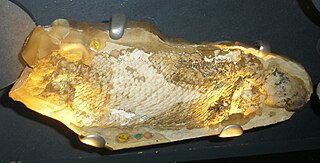
Lungfish are freshwater vertebrates belonging to the class Dipnoi. Lungfish are best known for retaining ancestral characteristics within the Osteichthyes, including the ability to breathe air, and ancestral structures within Sarcopterygii, including the presence of lobed fins with a well-developed internal skeleton. Lungfish represent the closest living relatives of the tetrapods. The mouths of lungfish typically bear tooth plates, which are used to crush hard shelled organisms.

Neoceratodus is a genus of lungfish in the family Neoceratodontidae. The extant Australian lungfish is the only surviving member of this genus, but it was formerly much more widespread, being distributed throughout Africa, Australia, and South America. Species were also much more diverse in body plan; for example, the Cretaceous species Neoceratodus africanus was a gigantic species that coexisted with Spinosaurus in what is now the Kem Kem Formation of Morocco. The earliest fossils from this genus are of Neoceratodus potkooroki from the mid Cretaceous (Albian-Cenomanian) Griman Creek Formation of Australia; remains from the Late Jurassic of Uruguay assigned to this genus probably do not belong to the genus.

Dipnorhynchus is an extinct genus of marine lungfish from the middle Devonian period (Emsian) of Australia.

The Gnathorhizidae are an extinct family of lungfish that lived from the late Carboniferous until the middle Triassic. Gnathorhizid fossils have been found in North America, Madagascar, Australia, and possibly Eastern Europe and South Africa. They are characterized by high-ridged toothplates that form cutting blades and a reduction in cranial bones.
Diabolepis is an extinct genus of very primitive marine lungfish which lived during in the Early Devonian period. It contains a single species, D. speratus of Yunnan, China, from the mid-late Lochkovian of the Xitun Formation. It is one of the oldest known lungfish genera. It is the only member of the family Diabolepididae and the order Diabolepidiformes, although neither of these parent taxa have been officially described, despite their names being in scientific usage.

Edward B. 'Ted' Daeschler is an American vertebrate paleontologist and Associate Curator and Chair of Vertebrate Biology at the Academy of Natural Sciences in Philadelphia. He is a specialist in fish paleontology, especially in the Late Devonian, and in the development of the first limbed vertebrates. He is the discoverer of the transitional fossil tetrapod Hynerpeton bassetti, and a Devonian fish-like specimen of Sauripterus taylori with fingerlike appendages, and was also part of a team of researchers that discovered the transitional fossil Tiktaalik.

Porolepiformes is an order of prehistoric lobe-finned fish which lived during the Devonian period. They are thought to represent the sister group to lungfish. The group contains two families: Holoptychiidae and Porolepididae.
Amadeodipterus is an extinct genus of lungfish which lived during the Devonian period. Fossils have been found in Central Australia.

Chirodipterus is an extinct genus of marine lungfish which lived during the Devonian period. Fossils have been found worldwide, including Germany, China, eastern & western Australia, and the United States (Michigan). However, it has been suggested that the genus as currently defined is polyphyletic, in which case only the German type species would belong to the genus.
Uranolophidae is an extinct family of prehistoric lungfishes which lived during the Late Devonian period. Fossils have been found in North America.
Melanognathus is a genus of prehistoric lungfish which lived during the Devonian period.
Ichnomylax is an extinct genus of lungfish which lived during the Devonian period. Fossils have been found in Australia and Russia.
Rhynchodipteridae is a family of prehistoric lungfishes which lived during the Devonian period.
Eoctenodus is an extinct genus of prehistoric sarcopterygian or lobe-finned fish.
Devonosteus is an extinct genus of prehistoric marine lobe-finned fish known from the Late Devonian. It contains a single species, D. proteus from the late Frasnian of Wildungen, Germany. It has sometimes been considered a lungfish of the family Holodontidae, but this remains uncertain as the original specimen may be lost. Alternatively, it may be a tristichopterid, a type of basal tetrapodomorph.
Mioceratodus is an extinct genus of lungfish in the family Neoceratodontidae, which also contains the extant Queensland lungfish. It is known only from Oligocene and Miocene-aged sediments in Australia, although phylogenetic evidence supports it having first diverged from its closest relative, Neoceratodus, during the Late Jurassic or Early Cretaceous period.
Rhinodipterus is an extinct genus of prehistoric dipnoan sarcopterygians or lobe-finned fish, that lived in the Devonian Period, between 416 and 359 million years ago. It is believed to have inhabited shallow, salt-water reefs, and is one of the earliest known examples of marine lungfish. Research based on an exceptionally well-preserved specimen from the Gogo Formation of Australia has shown that Rhinodipterus has cranial ribs attached to its braincase and was probably adapted for air-breathing to some degree as living lungfish are. This could be the only case known for a marine lungfish with air-breathing adaptations.

Paraceratodus is an extinct genus of prehistoric lungfish. Only one species, P. germaini, is known from the latest Permian or earliest Triassic period of Madagascar. Phylogenetic evidence supports it being the most basal member of the suborder Ceratodontoidei, which contains modern lungfish, and as with the rest of the order it likely diverged during the late Carboniferous.

Ceratodontiformes is the only extant order of lungfish, containing the families Neoceratodontidae, Lepidosirenidae, and Protopteridae as well as many other extinct groups. Members of this group are the only lungfish known to have survived the Permian-Triassic extinction event. Although lungfish originated in marine environments, the Ceratodontiformes have been an exclusively freshwater group since the Carboniferous. This order was formerly considered the suborder Ceratodontoidei.

The Mandagery Sandstone is a Late Devonian geological formation in New South Wales, Australia. It is one of several famed Australian lagerstätten, with thousands of exceptional fish fossils found at a site near the town of Canowindra.











